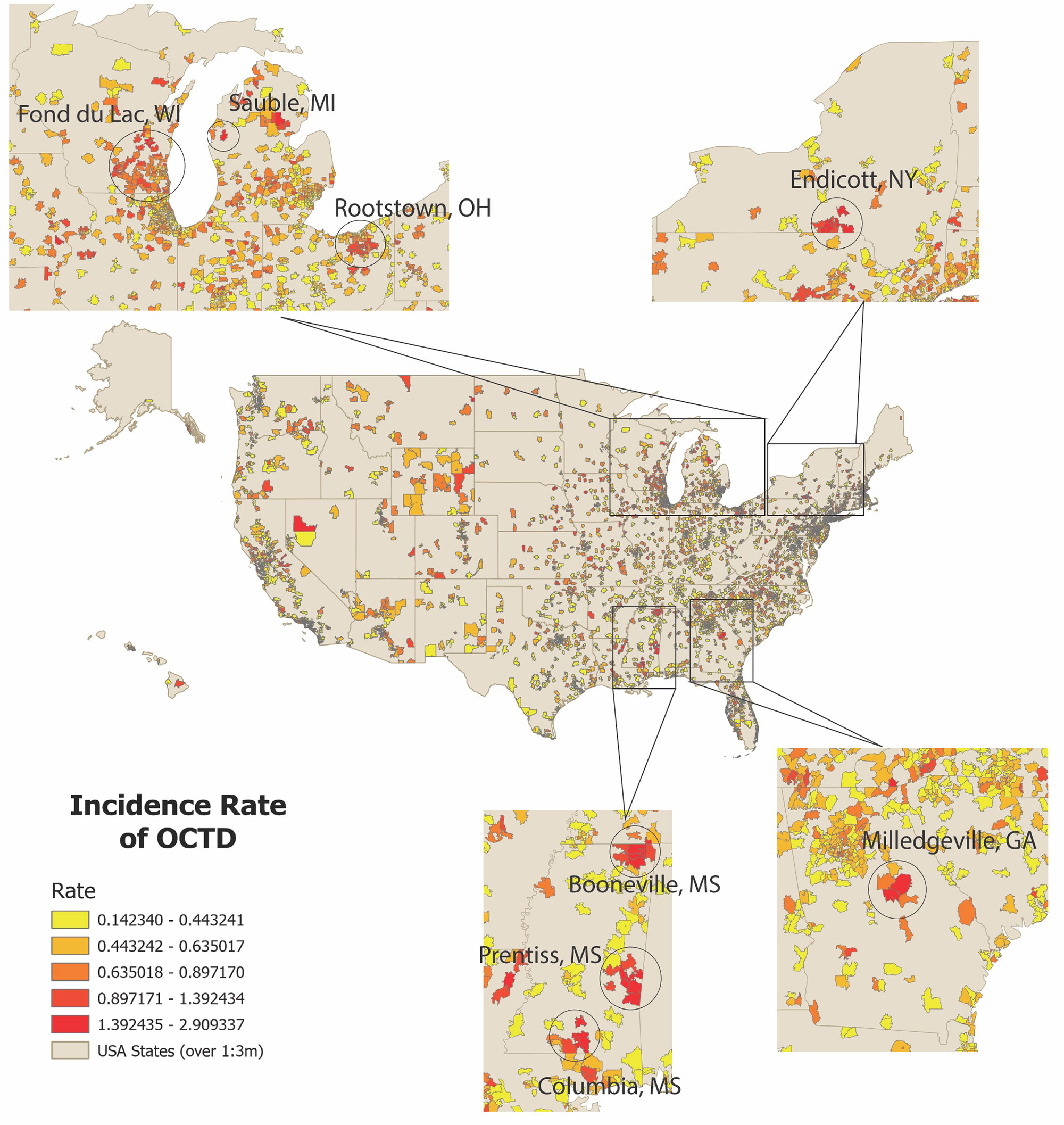Session Information
Date: Monday, November 14, 2022
Title: Abstracts: Systemic Sclerosis and Related Disorders – Clinical II: Clinical Phenotypes
Session Type: Abstract Session
Session Time: 9:00AM-10:30AM
Background/Purpose: Systemic sclerosis (SSc) is a rare autoimmune disease characterized by fibrosis of the skin and internal organs, vascular abnormalities, and autoantibody formation. The etiology of SSc is unknown, but it is thought to arise in genetically predisposed individuals after exposure to an environmental factor. Occupational, bacterial, and viral factors including silica dust, Rhodotorula glutinis, and Epstein Barr virus, have been cited as potential environmental triggers of SSc. We hypothesized that SSc exhibits a non-random geographic distribution in a US Medicare beneficiary cohort between 2014 and 2018.
Methods: We selected beneficiaries from the US Medicare database that had diagnosis codes associated with SSc and other connective tissue disease (OCTD). We calculated incidence rates for SSc and OCTD in each zip code in the United States. Using ArcGIS we plotted the incidence of OCTD and SSc and conducted global and local Moran’s I spatial autocorrelation to identify potential clusters of disease. We also executed optimized hot spot analysis, which utilizes the Getis-Ord Gi statistic, to evaluate statistically significant hot and cold spots.
Results: Our study population consisted of 207,467 OCTD beneficiaries between the years 2014 and 2018. Our cohort is 68.2% female and 86.8% White. 29.8% of the beneficiaries in our cohort resided in the Southeastern US. Of the 207,467 OCTD beneficiaries, 55,696 are characterized as SSc beneficiaries. The SSc specific beneficiary cohort is 67.7% female, 83.3% White and most beneficiaries in the Southeastern US between 2014 and 2018. We found statistically significant clusters of OCTD and SSc across the United States using spatial autocorrelation (Figure 1). The Moran’s I for our OCTD global spatial autocorrelation is 0.05 with a z-score of 48.2 and a p-value of 0.00. The Moran’s I for our SSc specific global spatial autocorrelation is 0.35 with a z-score of 25.1 and a p-value of 0.00. Examples of specific clusters found in Wisconsin, Michigan, Ohio, New York, Georgia, Mississippi, and New Jersey are shown. We overlaid statistically significant clusters with superfund sites and found that several of these clusters occurred in zip codes containing at least one superfund site. Examples of clusters with co-location of superfund sites include Mississippi, New York, Wisconsin, and New Jersey. Notably, several of these locations are former wood preserving sites. We accessed contaminant information at these sites through the Environmental Protection Agency (EPA) website and compiled a list of potential OCTD and SSc inducing exposures. These contaminants include vinyl chloride, 1,2 dichloroethane, and other volatile organic compounds.
Conclusion: We identified statistically significant clusters of OCTD and SSc in the United States. Many of these hot spots are concentrated around areas of environmental contamination. Concentrated studies at these locations are necessary to describe the complexity of these cases.
To cite this abstract in AMA style:
Kosarek N, Romano M, Simms R, Andrew A, Moen E, pioli P, Whitfield M. Nationwide Distribution of Other Connective Tissue Disease (OCTD) and Systemic Sclerosis (SSc) in Areas of Environmental Concern [abstract]. Arthritis Rheumatol. 2022; 74 (suppl 9). https://acrabstracts.org/abstract/nationwide-distribution-of-other-connective-tissue-disease-octd-and-systemic-sclerosis-ssc-in-areas-of-environmental-concern/. Accessed .« Back to ACR Convergence 2022
ACR Meeting Abstracts - https://acrabstracts.org/abstract/nationwide-distribution-of-other-connective-tissue-disease-octd-and-systemic-sclerosis-ssc-in-areas-of-environmental-concern/

